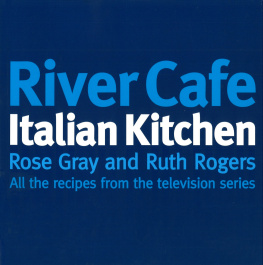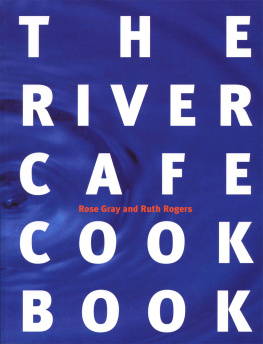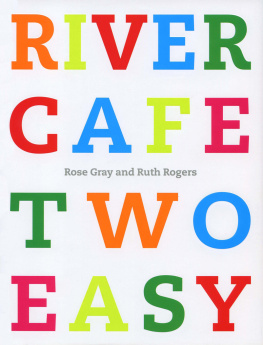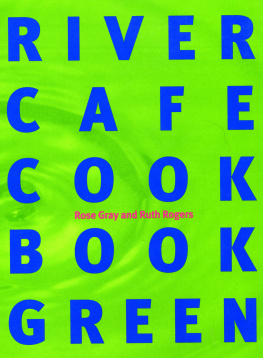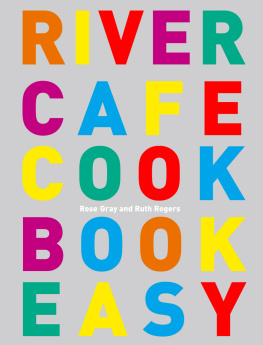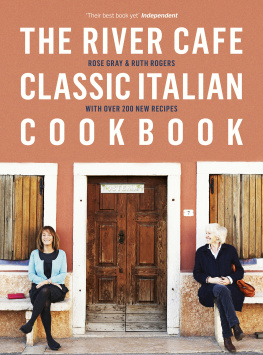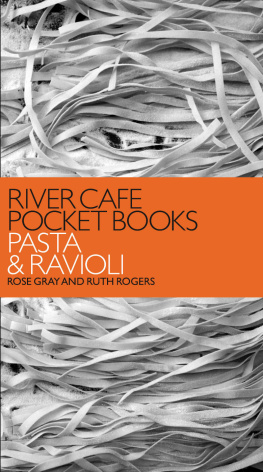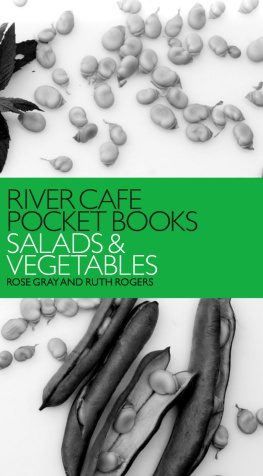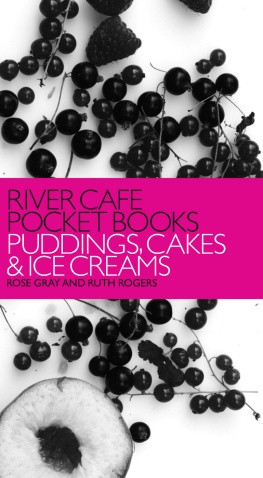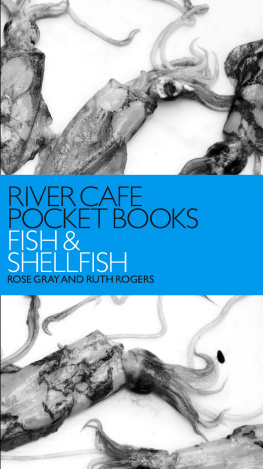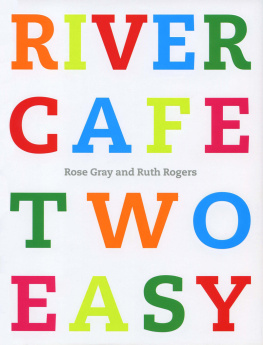Contents
List of Recipes
Introduction
In the summer of 1994 the River Cafe was redesigned to create a larger, more exciting space, with an Italian wood-burning oven as its focus. Just as we were inspired by the char-grill ten years ago, we are now passionate about the ovens immediacy and responsiveness. It has opened up all kinds of opportunities for doing what we enjoy most mixing the traditional with the modern.
We discovered how roasting at a high temperature intensifies the flavour of dishes such as porcini stuffed with pancetta and thyme. Roasting slowly, as the oven cools down, also has very special results a shoulder of pork, for example, rubbed with fennel seeds, garlic and chilli achieves a succulent flavour reminiscent of porchetta, traditionally sold from vans and market stalls all over Tuscany. We wrap artichokes with thyme in foil, squash ripe plums and apricots on vanilla-scented bruschetta, stuff pheasants with ricotta and sage and cook them all in the wood oven.
Experimenting at home with our domestic ovens, we achieved the same delicious effects by roasting at a high temperature on the low rack of the oven. Equally, by slow roasting, and ideally using an oven brick to increase the moisture, you can roast overnight very successfully. All the recipes titled wood-roasted use these techniques.
River Cafe Cook Book Two begins with seasonal fruit drinks as they begin the meals we serve in the restaurant. They range from freshly squeezed white peaches and sparkling dry Prosecco, an exuberant summer special, to freshly squeezed pomegranate mixed with campari and Prosecco, a delicious winter aperitivo with a beautiful colour.
Our second chapter, antipasti in a traditional Italian meal, includes many of our favourite, simple starters hardly recipes, just the pulling together of the finest ingredients to achieve classic dishes such as prosciutto with crisp Savoy cabbage, sweet aged balsamic vinegar and Parmesan, or a simple summer vegetarian carpaccio slices of young zucchini marinated in lemon juice and extra virgin olive oil with shavings of Parmesan and herb rocket. These recipes and others reflect our open approach to planning a meal, with many dishes that can be eaten as part of a meal or work equally well on their own.
Fish has increasingly become a focus of our main courses, reflecting a change in our customers preference. We have discovered and adapted many regional Italian recipes such as a variation on inzimino from Umbria, using salt cod, and baked whole loin of tuna with coriander from Sicily.
We have found new ways to cook duck, venison and game, changing traditional recipes to include other meats, for instance bollito misto with duck. Butchers have responded to our need to know about the breeds and feeds of animals and we love to cook the wonderful organic pork which is becoming increasingly available.
On recent trips to Italy we visited the wine and olive estates at Felsina and Selvapiana to select olive oil. We also went to the regions of Puglia and Sicily, where talking to cooks and producers we learned about their vegetables cima di rape, ceci and cicoria spices and the semolina bread called pagnotta.
The recipes in this, our second cookbook, have been stimulated by all these experiences and reflect the food we love to cook and eat at The River Cafe.
Rose Gray & Ruth Rogers London 1997
Drinks
Moscato dasti con cedro fresco
Moscato dasti with fresh lime
For 68 This is a winter drink. You need to use a cocktail shaker with a perforated top.
68 limes, fridge cold
1 bottle Moscato dAsti, cold
Squeeze the juice from 5 of the limes. Slice the sixth.
Pour the lime juice into the shaker. Add the Moscato very slowly, stirring gently, as it will immediately fizz up. Cover with the perforated top this will stop the fizzing and pour gently into champagne glasses. Serve with a slice of lime.
Spumante con borragine
Spumante secco with borage
For 68
150 g (5 oz) caster sugar
250 ml (8 fl oz) water
1015 fresh borage leaves, washed
juice of 2 lemons
1 bottle Spumante Secco or Prosecco, fridge cold
at least 1216 borage flowers
Using a small thick-bottomed saucepan, dissolve the sugar in the water, heating gently to make a syrup. When the syrup is hot, add the borage leaves. Stir and allow the borage to just wilt in the syrup. Remove from the heat, and cool. Strain the syrup, then add the lemon juice.
Put the syrup in a jug or cocktail shaker, add the wine (two-thirds wine to one-third syrup) and stir. Pour into champagne glasses, adding a few borage flowers to each glass.
Bellini I
For 68
8 ripe yellow peaches
100 g (4 oz) caster sugar
a good shot of Vecchio Romagna (Italian brandy)
1 bottle Prosecco, fridge cold
Preheat oven to 200C/400 F/Gas 6.
Halve the peaches and remove the stones. Place the half peaches in a china baking dish and sprinkle with the caster sugar and Vecchio Romagna. Cover with foil and seal. Bake the peaches for 1520 minutes. They should become slightly softer and the juices will begin to run. Remove from the oven and allow to cool.
Put the peaches and their juices in a food processor and pulse-chop. Push the pulp through a nylon fruit sieve.
Using a large cocktail shaker or jug with a lid, pour in 4 champagne glassfuls of peach pure, and add the same volume of Prosecco. Stir with a long spoon or stick to combine and also to prevent over-fizz. Pour into champagne glasses through the lid of the cocktail shaker.
Bellini II
For 68
1012 ripe white peaches
1 bottle Prosecco, fridge cold
Choose very ripe white peaches. Cut them in half and remove the stones. Using an orange juicer, the rotary kind, press the juice from the peaches as you would from oranges.
Pour the peach juice into a jug or cocktail shaker with a lid. Add the same volume of Prosecco and stir to control the fizz and consequent overflow. Cover with the lid, and pour gently into champagne glasses.
Arance sanguigne e prosecco
Blood oranges and prosecco
For 68
89 blood oranges, according to juice obtained
1 bottle non-vintage Prosecco
Squeeze the oranges into a cocktail shaker or jug. Add a little Prosecco and stir with a spoon to still the fizz, then add about two-thirds of the remaining wine (you want to have slightly less orange juice than Prosecco). Pour into champagne glasses through the perforated top of the cocktail shaker.
Melone e prosecco
Melon and prosecco
For 68
1 very ripe cavaillon or canteloupe melon
juice of 1 lemon, or 1.1/2 limes
1 tablespoon caster sugar, or more
1 bottle Prosecco, fridge cold
Cut the melon in half. Scoop out the seeds and put them in a fruit sieve over a bowl to collect the juices. Scoop the rest of the ripe pulp from the skin and put in a food processor. Pulse-chop to liquefy. Sieve the pulp, adding it to the melon juices collected.
Next page

